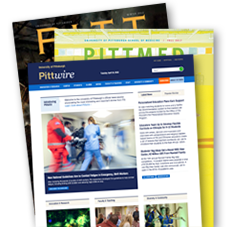Pitt Students Engineer Child Location Device
PITTSBURGH––When child "leashes" were introduced as a way of preventing toddlers from wandering away from mom and dad, the innovation was met with mixed reactions. Proponents pointed out that leashed children were no longer in danger of getting lost or kidnapped; opponents, however, couldn't escape the obvious parallel to pets on leashes.
Now, students at the University of Pittsburgh have come up with a high-tech alternative-––dubbed Wee Know––that helps protect children without making little "Lucy" look like "Lassie."
The Wee Know child protection device will make its Pittsburgh debut April 16 during Pitt's "Cool Devices" event, a showcase of Pitt inventions sponsored by the Office of the Provost. The device was unveiled March 22 in Boston at March Madness of the Mind, an annual student inventors conference sponsored by the National Collegiate Inventors and Innovators Alliance (NCIIA) and the Lemelson Foundation for the Study of Invention and Innovation.
Pitt's School of Engineering (SOE) has been represented by a student team in this national invention showcase during four of the past five years. Student inventors from across the country submit proposals, but only the top ideas are selected.
Wee Know was developed by Alex Bevly, Carl Taylor, and Randy Maruschock, graduate students in Pitt's Department of Electrical Engineering; Jared Schoenly, a junior in the Department of Mechanical Engineering; and James Patla, who received the Bachelor of Science degree in computer engineering from Pitt last spring.
The students began the project in January 2002, as part of a Product Realization class. NCIIA donated more than $18,000 in grants to support the project, and Michael Lovell, director of the SOE's Swanson Center for Product Innovation and an associate professor of mechanical engineering, and Marlin Mickle, a professor of electrical engineering, were faculty advisors.
Wee Know uses wireless radio frequency signals between the parent's device and up to four children's appliances. The children's device, which is worn on the wrist, resembles a watch; the parent's, which looks like a pager, can be clipped onto a belt or other clothing.
When a child wanders beyond a predetermined distance, the parent's mechanism no longer receives a signal and an alarm rings. Parents can adjust the distance allowed between the parent and the child before the alarm is triggered.
"A parent might want a shorter distance in a store or a crowd, and perhaps a greater distance in a playground or an open field," said Maruschock.
Though there are similar products on the market, Wee Know will be more effective than its competitors, said Maruschock. With Wee Know, both the parent's and the child's devices have alarms, so both the parent and anyone around the child can be alerted. The device also will have a forced-removal feature. If someone tries to remove the device, the alarm sounds. It also can be activated manually if the child wanders out of sight.
###
4/10/03/mgc
Media Resources
Schools of the Health Sciences Media Relations
For more information about Pitt's schools of dental medicine, health and rehabilitation sciences, medicine, nursing, pharmacy, and public health, click here >
To locate stories from health science schools prior to 2013, visit the UPMC news archives »
Urgent Question?
University of Pittsburgh news reps are available to answer urgent media inquiries. Outside of regular business hours (Mon-Fri, 8:30 a.m.-5 p.m.), please email us at media@pitt.edu.
News reps for University of Pittsburgh Health Sciences schools can be reached outside of regular business hours through the paging operator at 1+412-647-2345.


